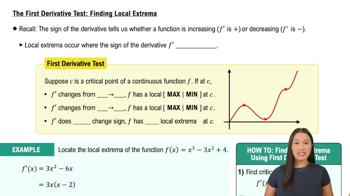Table of contents
- 0. Functions7h 52m
- Introduction to Functions16m
- Piecewise Functions10m
- Properties of Functions9m
- Common Functions1h 8m
- Transformations5m
- Combining Functions27m
- Exponent rules32m
- Exponential Functions28m
- Logarithmic Functions24m
- Properties of Logarithms34m
- Exponential & Logarithmic Equations35m
- Introduction to Trigonometric Functions38m
- Graphs of Trigonometric Functions44m
- Trigonometric Identities47m
- Inverse Trigonometric Functions48m
- 1. Limits and Continuity2h 2m
- 2. Intro to Derivatives1h 33m
- 3. Techniques of Differentiation3h 18m
- 4. Applications of Derivatives2h 38m
- 5. Graphical Applications of Derivatives6h 2m
- 6. Derivatives of Inverse, Exponential, & Logarithmic Functions2h 37m
- 7. Antiderivatives & Indefinite Integrals1h 26m
- 8. Definite Integrals4h 44m
- 9. Graphical Applications of Integrals2h 27m
- 10. Physics Applications of Integrals 2h 22m
5. Graphical Applications of Derivatives
The Second Derivative Test
Problem 44
Textbook Question
Each of Exercises 43–48 gives the first derivative of a function y = ƒ(𝓍). (a) At what points, if any, does the graph of ƒ have a local maximum, local minimum, or inflection point? (b) Sketch the general shape of the graph.
y' = 𝓍² ― 𝓍―6
 Verified step by step guidance
Verified step by step guidance1
First, identify the critical points by setting the first derivative y' = 𝓍² - 𝓍 - 6 equal to zero and solving for 𝓍. This will help us find potential points for local maxima, minima, or inflection points.
Factor the quadratic equation 𝓍² - 𝓍 - 6 = 0 to find the values of 𝓍. The equation can be factored as (𝓍 - 3)(𝓍 + 2) = 0, giving the critical points 𝓍 = 3 and 𝓍 = -2.
To determine whether these critical points are local maxima or minima, use the second derivative test. Compute the second derivative y'' by differentiating y' = 𝓍² - 𝓍 - 6 again, resulting in y'' = 2𝓍 - 1.
Evaluate the second derivative at the critical points: y''(3) and y''(-2). If y''(𝓍) > 0, the point is a local minimum; if y''(𝓍) < 0, the point is a local maximum. If y''(𝓍) = 0, further analysis is needed to determine the nature of the point.
To find inflection points, set the second derivative y'' = 2𝓍 - 1 equal to zero and solve for 𝓍. This will indicate where the concavity of the function changes, which is a characteristic of inflection points.
 Verified video answer for a similar problem:
Verified video answer for a similar problem:This video solution was recommended by our tutors as helpful for the problem above
Video duration:
5mPlay a video:
Was this helpful?
Key Concepts
Here are the essential concepts you must grasp in order to answer the question correctly.
First Derivative Test
The First Derivative Test is a method used to determine local extrema of a function. By analyzing the sign of the first derivative, we can identify intervals where the function is increasing or decreasing. A local maximum occurs where the derivative changes from positive to negative, while a local minimum occurs where it changes from negative to positive.
Recommended video:

The First Derivative Test: Finding Local Extrema
Critical Points
Critical points are values of x where the first derivative is either zero or undefined. These points are essential for finding local maxima, minima, and inflection points. In the given derivative, we find critical points by solving the equation y' = 0, which helps us identify where the function's behavior changes.
Recommended video:

Critical Points
Inflection Points
Inflection points occur where the concavity of a function changes, which can be determined by analyzing the second derivative. However, in the context of the first derivative, inflection points can also be inferred from changes in the behavior of the first derivative itself. Identifying these points helps in sketching the overall shape of the graph.
Recommended video:

Critical Points

 6:02m
6:02mWatch next
Master The Second Derivative Test: Finding Local Extrema with a bite sized video explanation from Callie
Start learningRelated Videos
Related Practice



